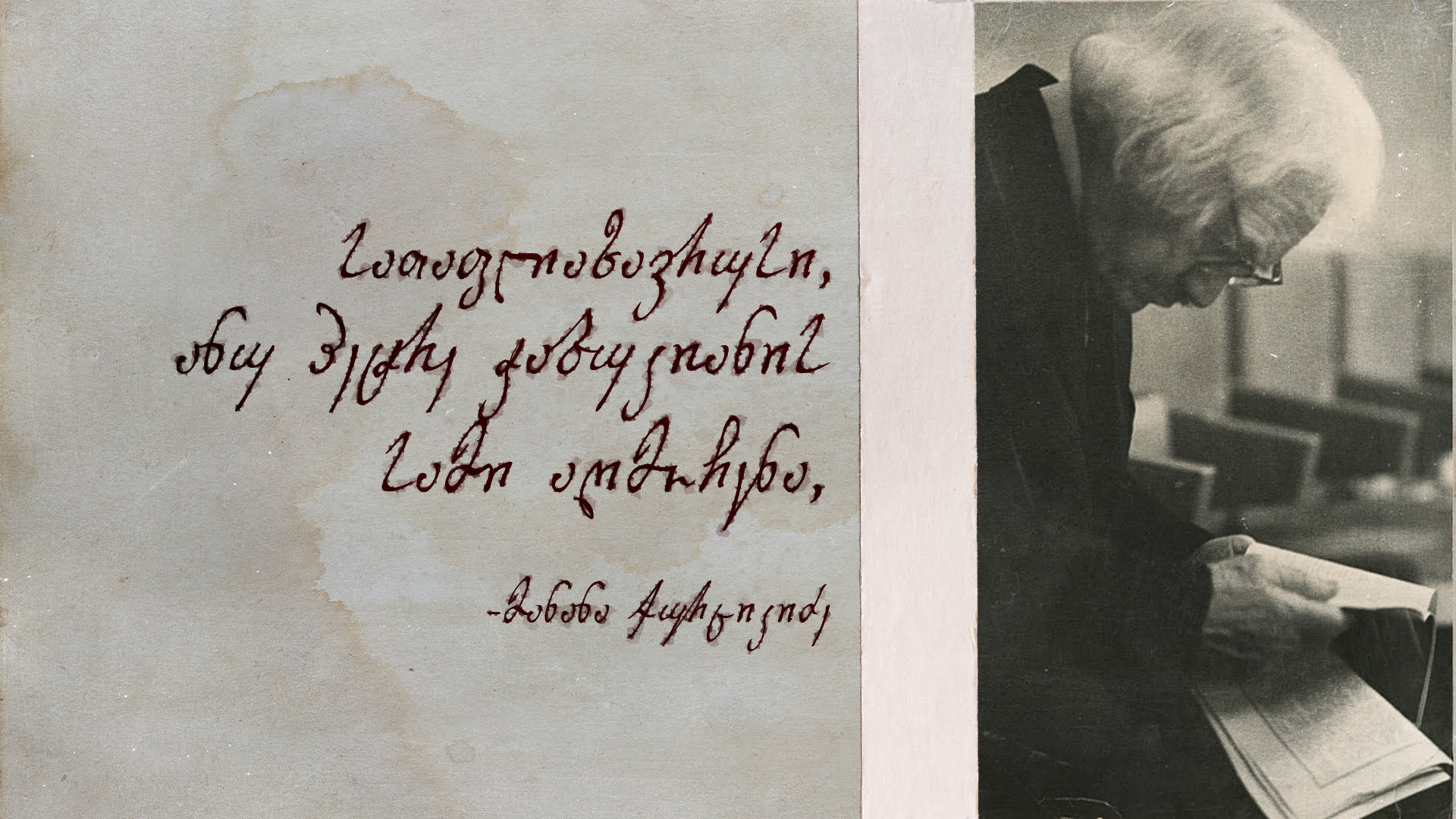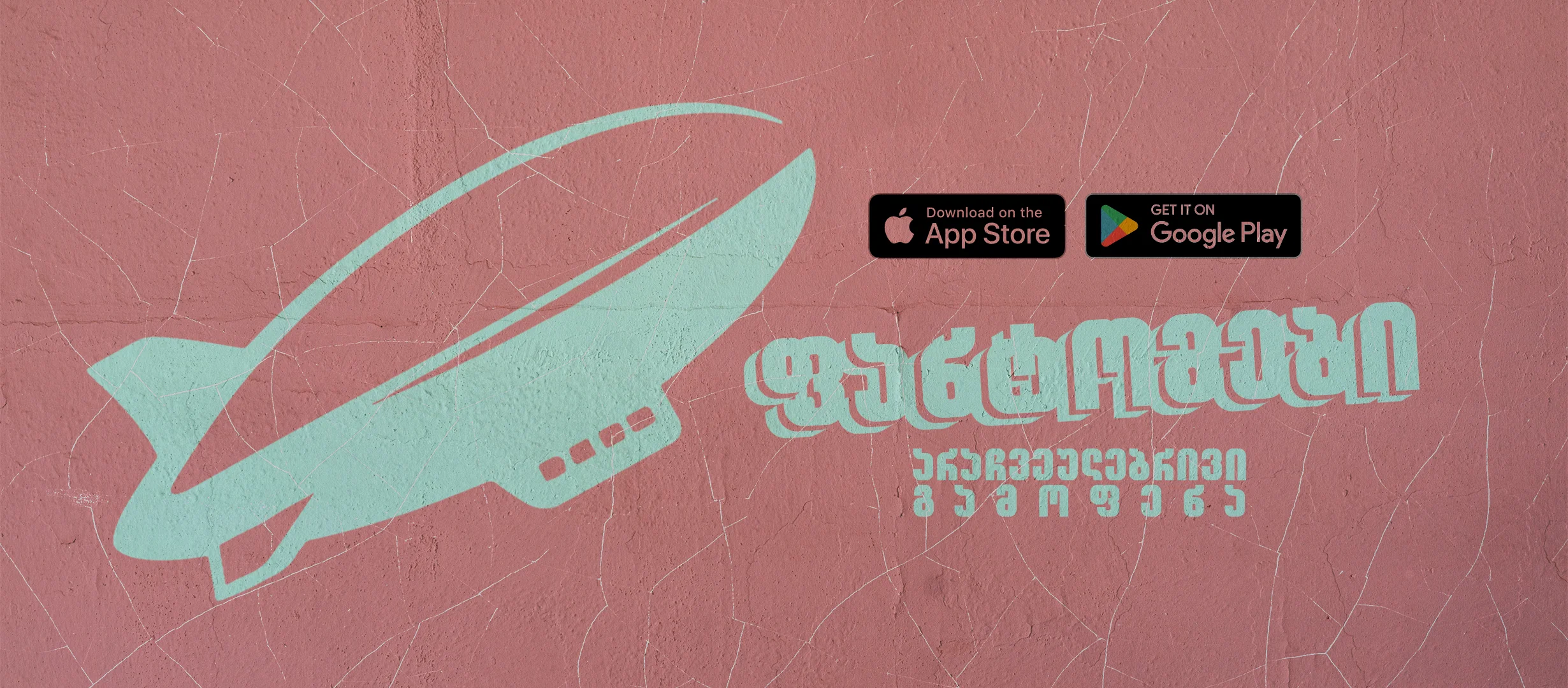Author: Manana Kurtsikidze
First Discovery…
It was 1924, May. A geography teacher took his students to the Tetramitsa. He believed an engaging excursion would open the students’ minds more than tedious, hours-long lessons within the school walls. From the top of a hill (from where nowadays one can see a building constructed with the latest technologies), a marvelous sight unfolded: the Colchis plain, the Bagrati Cathedral, the Ukimerion hill, and the mirror-like Rioni river with white stones in the center of the old city. Teacher Petre discussed everything broadly, covering the importance of Gelati, the era of David Agmashenebeli, mosaic painting, and Khakhuli.
A sunbeam reflected off a piece of flint half-hidden at the base of a bush. He bent down, picked it up, and put it in his pocket. This small flint would completely change Petre Chabukiani’s life.
In the morning, he returned to that place. He searched everywhere: in rock crevices, in caves. He found similar finds and was convinced that two days ago, he had not found a mere flint shard but a tool made and used by primitive humans.
At that time, there was still a belief that the Stone Age had bypassed Georgia (or vice versa). The museum management and scientific staff initially met his discoveries with ironic skepticism. Yet, he convinced everyone to establish an archaeological department.
He was tireless. He searched, found, and studied. The museum was filled with kilograms of stones. He was not even paid a salary there, let alone given tips as a worker. He was determined to find something that would not only prove the existence of primitive humans but also provide more information about who they were, what they were like, and their way of life. Then, he discovered a stone hoe, suggesting that the early inhabitants of Kutaisi practiced agriculture. He also found a boat-shaped tool for grinding grain.
He unearthed primitive chisels, beautifully polished knives, wooden sharpening tools, flints, and various agricultural and hunting implements. These findings indicated that the residents of Tetramitsa were not mere passersby or wanderers but indigenous people who fully utilized their local environment. He also found arrowheads with shafts, rounded spearheads, bracelets, and figurines.
Clearly, the inhabitants of this region at that time had an appreciation for beauty. They strived to make items functional and aesthetically pleasing, investing considerable effort into this endeavor.
Petre…
He was born in 1889 in Kutaisi. His mother was often ill, and his father gave him to be raised by a friend, widow Anya Kuchukhidze. This lady awakened in Petre an insatiable desire to learn and search. She taught the orphaned child to read and write and enrolled him in a parochial school.
After finishing primary school, his father’s financial situation forced him to work as an apprentice at a Georgian clothing tailor. He spent seven years in the circle of artisans and workers in Batumi. Fortunately, his teacher did not interfere with his study and reading, and Petre devoted all his free time to self-education. He studied Russian and Turkish well.
When his father, Ivane Chabukyan, had the opportunity to help his son achieve his biggest dream, Petre was already 19 years old, and all high schools refused to accept him.
Petre decided to take exams in Russia and continue his education there. In 1912, he went to Pskov. He graduated from high school and began to think about university. He learned about educational institutions accessible to young people of modest means in the city of Dorpat (Tartu), near Pskov.
He chose the geography department of the Faculty of Natural Sciences.
Returning to Georgia in 1919, he was appointed as a teacher at the Khashuri gymnasium. Since 1921, he taught at the oldest school in Kutaisi, located on Ukimerioni Hill.
Second Discovery…
After his initial discoveries at Tetramitsa, a certain force kept drawing him back. Looking at the Sataplia rock, just three kilometers from Tetramitsa, he thought, “If primitive people lived here, they could have also lived in Sataplia too.” Especially since, according to his hypothesis, Sataplia rock, Tetramitsa, Motsameta mountain, and Gelati mountain formed around the same time. “These four large massifs are situated on Jurassic and Cretaceous deposits. These are limestones from the sedimentary period. After the Caucasus turned into land, the single massif of the great rock fragmented due to erosion and separated from each other.”
First, he discovered four small basins where shepherds had taken shelter, but he persistently continued his search. He meticulously studied the environment: a bare mountain chain, a Trench, a limestone slope where wild bees once nested. That’s why they called it the honey rock (“Tapli” in Georgian means honey). A stream that flowed straight down the middle of the mountain and disappeared caught his attention. It was at this spot that a second creek vanished. He circled around the rock and noticed an apparent stream on the other side, which seemed colder and more watery. He concluded that somewhere in the middle of the rock, other waters joined it, and the rock “filtered the water that passed through it, making it purer.” An astonishing, mysterious, and suffocating silence enveloped the area momentarily. It was then that he heard strange sounds emanating from the rock’s center. He widened the stream’s entrance with his hand, struck a match, and slowly reached inside. The cool air blowing out extinguished the flame, confirming to Petre that a large, deep cauldron lay hidden behind the hole.
He first began to examine the cauldron’s exterior. He dropped a belt into it and realized it didn’t hit the rock but fell somewhere far below. He then lowered a rope to measure the depth. The depth seemed manageable, so he decided to make the first descent himself. On July 26, 1925, he went through the bushes at the creek’s entrance. The entrance was only about 70 cm high. Lying down, he crawled into the cave opening with an oil lamp in his hand. He traveled six meters, then stood up. The lamp’s light reflected off the cave walls, revealing an array of stalactites and stalagmites. His feet slipped; walking was difficult, so he decided to return.
A week later, on August 2, accompanied by six young men, he approached the Sataplia cave… In the 600-meter-long tunnel with four large halls, he identified at least one main hall where nature had created a remarkable display. The same creek that had led him to this path flowed slowly through the cave’s center. Water dripping from the stalactites merged with it, producing a peculiar sound. Petre named this sound the “song of the mountain’s heart.”
Sataplia
Today, five caves of Sataplia have been discovered. Their absolute heights vary from 275 meters to 405 meters. The Sataplia Cave is the only one of the five that is used for tourist purposes. It is located on Samgurali Mountain, at an altitude of 360 meters above sea level. The cave was formed in layered limestones of the Lower Cretaceous. The entrance is situated at the bottom of a funnel-shaped basin, and visitors are drawn to the sound of water murmuring from a dark gorge on the left.
Inside the cave, a forest of stalactites and stalagmites makes a significant impression, sometimes merging into columns and creating the impression of enchanting structures. In the center of the main hall stands a huge stalagmite topped with a stalactite.
The cave also features a small lake formed by a stream that flows into it.
Additionally, the cave is rich in chemical formations. The temperature inside remains around 11 degrees Celsius both in winter and summer.
Nearby, Petre Chabukiani planted a Colchis forest, abundant with relict and endemic species, and this area was declared a nature reserve. Here, one can encounter rare species of plants, animals, and birds.
…and that’s not all; something else has made Sataplia one of the most important discoveries in the world.
Discovery Three
It was 1933. The caretaker of Sataplia, with his characteristic eccentric persistence, continued to take care of every blade of grass and bush, every animal and bird in the Colchis forest. He roamed and examined the enormous boulders. Bending down to pick up a branch, he made the most significant discovery of his life, bringing his name into world history. He found the imprint of a strange and massive dinosaur about 500 meters from the Sataplia cave.
Subsequent scientific discoveries proved that these dinosaur tracks were made here 12 million years ago. This area had an ocean bay, with the prints left on a soft limestone layer by two dinosaurs.
In Sataplia, footprints of three different dinosaur species have been found. Among these, a bipedal imprint belonged to a dinosaur up to two meters tall, while a dinosaur with a three-toed imprint, according to scientists, could easily peer into the upper window of a five-story building.
This was during the Mesozoic era, a period when giant reptiles dominated the land, sea, and air. There were placodonts and nothosaurs in the sea, gigantosaurus and prontosaurs on land, and pterodactyls in the air. In Sataplia, over three hundred various paleontological traces remained preserved in several layers.
This site is one of the rarest and most important in the world. Petre commented on this, saying, “It seems dinosaurs walked here in herds. Six-meter-long predators passed through the lower layer, leaving sharply imprinted tracks. Then, the ocean passed over these tracks and covered them with heavy layers. The clay gradually hardened and acquired a solid form. Who knows how much time passed before this layer reappeared, bearing another trace of herbivorous animals.”
Traces similar to these are found only in North America. In scientific circles, this track is known as the “Satapliasaurus.”
(The author’s imagination of these words would make even Spielberg jealous.)
Keeper
in 1928, Petre Chabukiani was appointed as the official head of protecting cultural and natural monuments. He explored and studied the remains of the old city on Arkiel Hill, the Mtsvanekavila Basilica, Okros Chardakhi, and Geguti. It required considerable effort to remove several meters of earth from the Bagrati Temple and reveal its main structure at its full height.
He remembered all historical details as if he were an eyewitness to the events and buildings. His hypotheses ranged from “I know” to “I feel.”
Paleolithic settlements were discovered on both sides of the Tskaltsitela River. In 1952-53, 60 mounds were found. He preserved the archives of the Imereti eparchy, the classical school, and the seminary of Saint Nino.
He was the only one who could bring to life what nearly everyone considered utopian. Legends circulated about him, poems and stories were written, busts sculpted, and films made. He was ever-present, resembling a kind astrologer with a walking stick and binoculars, his hair long and gray.
He deeply believed that his city did not have and would not have a founder figure like King Vakhtang Gorgasali for Tbilisi because “it is impossible to determine the birth date of his city. This area, precisely where the city originated, had been inhabited since the Stone Age.”
The area surrounding the dinosaur tracks and the honey cave of Sataplia is always bustling. He himself rests there, in the midst of the reserve. A granite monolith – “orphan stone” – was erected on his grave by Otiya Ioseliani, a Georgian writer who called Petre a living legend: “Everyone dies, and the remains of all lie in cemeteries. Petre’s remains are in Sataplia because he was unique and irreplaceable. He deserved to stay here, in the world he discovered, created, and cared for.”
…a huge animal emerged from the water, leaving a deep imprint on the soft limestone soil… Millions of years later, it was discovered by Petre Chabukiani, who bent down to pick up a branch.


